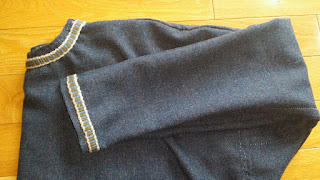Well, the push for Pennsic is on. I don't have a ton of proper 13th century clothing as I don't often do events which are longer than 2 days. Time to improve the stash. I made 2 hoods, three pairs of brais, three tunics, three shirts and 2 coifs. Nothing new about the process so if you are interested please see my prior posts. My goal was to own at least 4 sets of decent clothing to last me the week. one set of the clothing should be decent enough to be considered "court" garb.
I had been on a weaving kick for a while so I had quite a stash of trim I made on my inkle loom. Time to put some to use. I found this plain white one I made with no real purpose in mind other than to practice and test weaving this really thick yarn I had. I decided to whip up a pilgrim's bag like one found in the Morgan Bible.
Here are a couple close ups from the Morgan (Crusader) Bible:
http://www.themorgan.org/node/560/zoomify
http://www.themorgan.org/node/570/zoomify
I have created a pilgrim's shoulder bag from a portion of a cotton curtain purchased from Salvation Army.
I purchased three curtains for $8. Each curtain was 6X9 for a total of 162 square foot of canvas fabric. That comes to about five cents per square foot. The strap for the bag was woven from a cotton yarn my mother-in-law gave to me when I started weaving. The tassels were made from threads pulled from the material. Not counting the cost of the thread used to sew this project together it appears it cost about 30~40 cents to make. The curtains were also lined with light weight cotton slightly thinner than an average bed sheet. I haven't planned on a use for the lining yet.

I didn't really have a pattern to work with. I compared the size of the bag in the images to the size of the wearers hand. I used that as my reference and created a paper template. When I looked at myself in the mirror with my paper bag it looked about right so I used that as my template. The bag was hand sewn using cotton thread.


I have created tunics before and there is nothing spectacular about them. The new ones I created were slightly different in size. I fitted the sleeves a little tighter and trimmed the cuff and collar of two of them.
Linen tunic, wool trim.
Wool fabric and wool trim.
I found some lovely wool from Salvation Army. Not many people know that thrift stores sell raw fabric as well as used clothing. There is a section in my local store which has material on hangers and sometimes still on the bolt. I purchase 6 yards of this lovely thick wool fabric. I also purchase four yards of the lovely blue wool you see in the tunic above.

Now comes the real head scratcher that this post was intended to focus on. I found the following images in the Morgan Bible although I had never seen a pattern for them. I reached out to some A&S groups I'm in for advice how to construct one.
My issue was regarding surcoats for men.
I came accross images of what appear to be men wearing surcoats with slits in the front so that the wearer can either don the sleeves or let them hang. I don't recall seeing anyone in the SCA do this sort of thing for the time period 1150~1250.
Here are a set of images from the Morgan Bible:
http://www.themorgan.org/node/565/zoomify
http://www.themorgan.org/node/570/zoomify
http://www.themorgan.org/node/571/zoomify
http://www.themorgan.org/node/602/zoomify
http://www.themorgan.org/node/630/zoomify
I couldn't seem to tell exactly how to construct the location of the slit.
I had two theories:
A) Simply fail to attach the sleeve and leave the front of the sleeve free or
B) Cut a separate slit slightly to the front of the side seam.
The image above has a few examples along with the basic tunic pattern I have used before. Some seem to have the sleeves only attached at the top, others seem to have only a small slit in the front.
Well without any real pattern to go by I proceeded to make three or four mock-ups from old bed sheets.
After a few mock-ups I decided to head back to the source. I found these two images on the same page of the Morgan Bible and I believe they are both supposed to represent the same person. It seemed to me that the sleeves are worn on in one image and off in the other but for the same man. From this image I am leaning towards having them attached as normal in the back and fully open in the front along the seam line.
I did mock-ups for both Option A and B above. I ended up with three mock-ups for option A.
The third version is what you see here. The shaping of the opening and slightly wider sleeve opening made the finished mock-up fit better and drape the way I wanted over my "non-medieval" shape.
The finished garment doesn't drape quite the same as the bed sheet version obviously. The wool is thicker than the bed sheet, but also, I lined the coat with linen. I expect to use this as my coat on cold weather days. With a linen shirt, wool or linen tunic and this surcoat along with a cape I expect to be warm even in the midst of winter.
Here is a close up of the woven trim I applied.























































